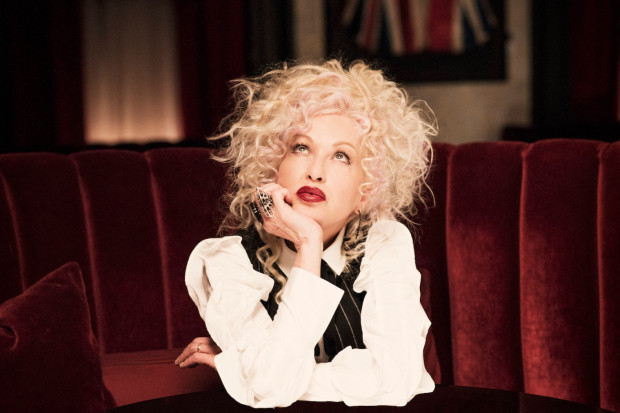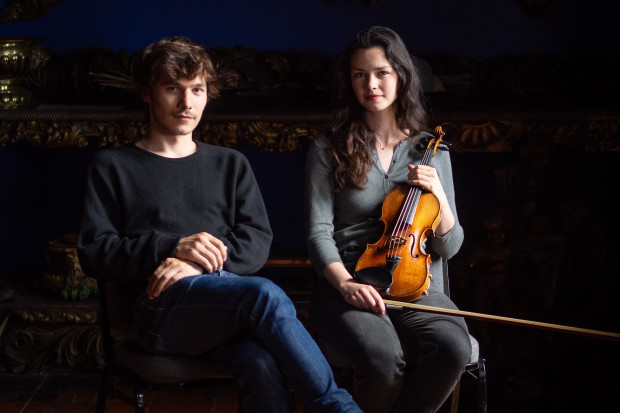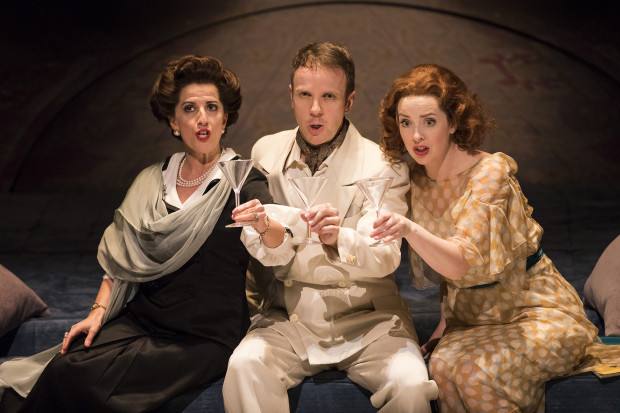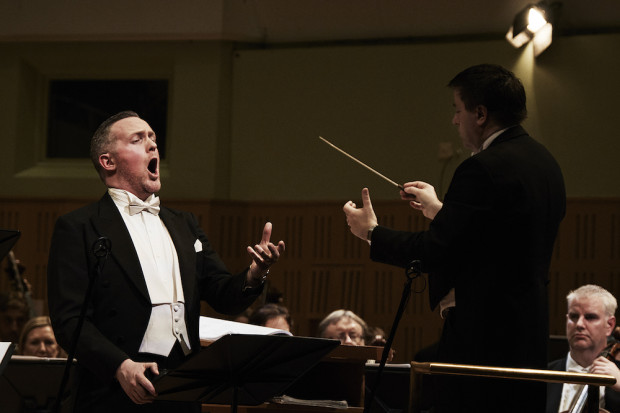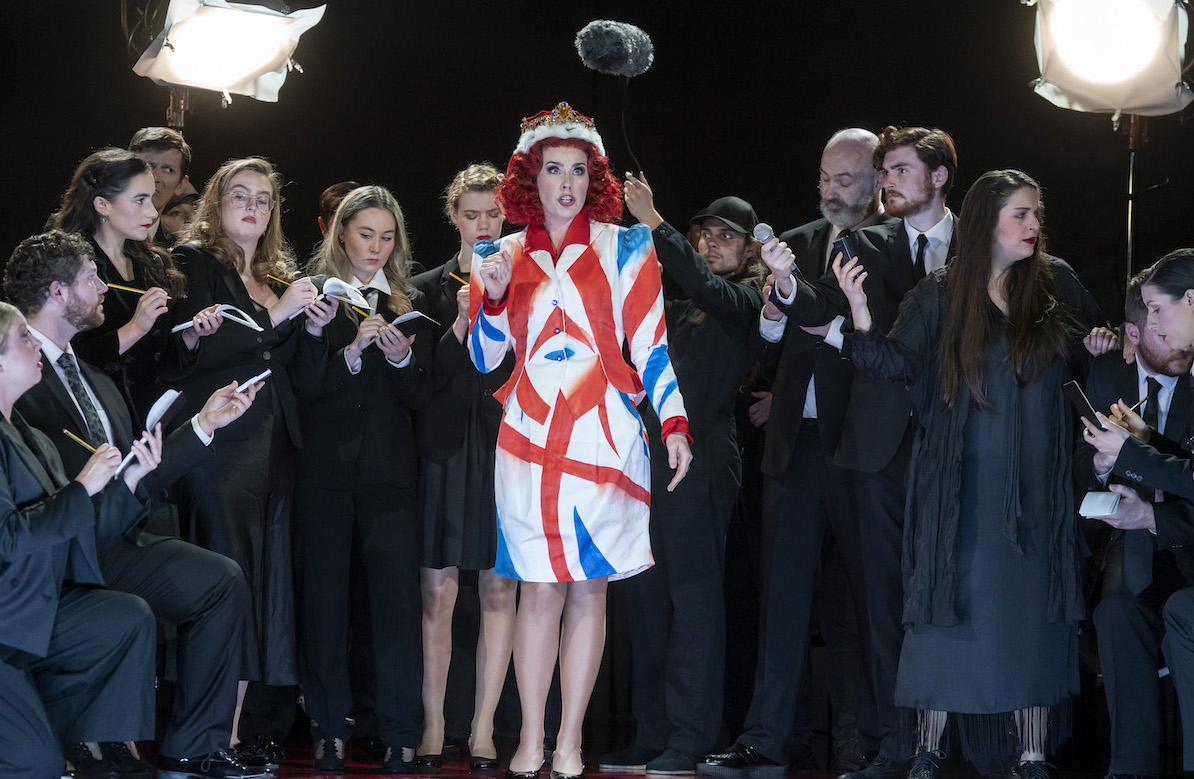
Anna Devin in 'Maria Stuarda' (Photo: Pat Redmond)
A Royal Conflict
Donizetti’s opera Maria Stuarda has a troubled history. During its 1834 dress rehearsal, the leads, in the roles of Maria Stuarda, queen of Scotland, and Elisabetta, queen of England, got in a fight. Whether this would have affected the performance longer-term we don’t know, since the King of Naples then cancelled the premiere due to strong language. It was revived with words, characters, and music changed, as Buondelmonte, before being staged in its original form in late 1835, censured again, and was subsequently little performed until the 1950s.
For Irish National Opera’s production (5 June, Gaiety Theatre), director Tom Creed has placed the action in modern (or modernish) times, opening with a press conference and closing with a political protest, complete with placards and paper crowns. In the lead roles are Tara Erraught as Maria Stuarda and Anna Devin as Elisabetta. The cast also features Arthur Espiritu as Roberto, the Earl of Leicester, loved by Elisabetta and in love with Maria, along with Callum Thorpe, Giorgio Caoduro and Gemma Ní Bhriain in supporting roles, and with Fergus Sheil conducting the Irish National Opera Orchestra and Chorus.
The opera centres on a fictional meeting between Mary Stuart and Elizabeth I, during a hunt at Fotheringhay Castle, where Stuart was imprisoned. The first act builds to this meeting, highlighting each queen’s internal conflict – Elisabetta’s in the choice whether to have Maria executed, and Maria’s in whether to behave deferentially to her captor. Eventually, Maria capitulates, Elisabetta humiliates her, and Maria becomes enraged, calling Elisabetta a ‘vile bastard’. The second act deals with the fallout of this meeting, Elisabetta signing Maria’s death warrant, and Maria sharing a quiet moment with George Talbot (Thorpe) before being executed in front of her admirers.
The leads meet only once, at the end of Act I, although this scene brimmed with tension and emotional electricity. Throughout the performance, there were some wonderful moments of duo and trio singing, especially in Act II between Elisabetta and Gugliemo Cecil (her adviser, who advocates for Maria’s execution, played by Caoduro), and between Maria, Cecil, and Talbot.
Confrontations
But Erraught and Devin shone as the best part of the performance. Devin sang Elisabetta as a charismatic villain, her voice a full, warm contrast with her austere outfits and manner. Even in her angry confrontation with Roberto in the second scene, her tone never wavered. She gave the impression of a queen with complete mastery over her public image – which made her fury at Maria at the close of Act I all the more striking. Likewise, her conflictedness over signing Maria’s death warrant in Act II, resolved seemingly more by impulse than reason, was fully convincing.
And Erraught, dressed throughout in a light, flowing floral dress in earthier tones than the rest of the cast (and seeming briefly to suggest a conflict between urban and rural), performed Maria with her usual exceptional commitment to the role. Her opening aria was full of the sweet joy of nature, but it was later that she really broke the heart. In her quiet anxiety in her prison, in her duet with Callum Thorpe, her voice came in beautifully controlled halting notes, and at the close, leading the chorus in prayer, her voice soared gently above the rest. Erraught is as effective an actor as a singer, speaking with her eyes of her fear and trepidation as Roberto sings to her of Elisabetta’s approach.
Under conductor Sheil, the Irish National Opera Orchestra provided a nimble and well-balanced support for the singers, and the sound of the chorus was full and solid. The rest of the cast sang well, mostly serving as foils for the two queens, though I must admit I had an easier time believing in the love between Maria and her nurse Anna (Gemma Ní Bhriain) than in the purported love triangle with Arthur Espiritu’s Leicester.
Unfortunately, the modernist staging led by director Tom Creed and set designer Katie Davenport never said as much as it wanted to, with the scenes often visually striking – a press conference on a blood-red stage, or a barren office – but at the same time feeling disjuncted. The costumes were striking, in particular Elisabetta’s numerous outfits – a bold suit in Union Flag colours, or a top hat and stiletto heels – and the occasionally absurdist garb of the chorus – bearskins, fencing uniforms, and football socks in one scene; paper crowns and pastel colours in another. The overall effect, though, was that the opera’s music and its visuals were working at cross-purposes, neither enhancing the other.
Still, I’ll always admire a production that takes risks and makes bold choices. This would have been easy to stage as a period costume drama but, while it may have been less incongruous, it also wouldn’t have given a deeper look at the characters. And for all the pomp of the show, it is Erraught and Devin’s commitment to their characters, to displaying their internal and external conflicts, and their extraordinary vocal prowess, that carries the opera to success.
Irish National Opera’s Maria Stuarda is in the Gaiety Theatre in Dublin for two more performances (9th and 11th June), then Cork Opera House (15th and 16th), National Opera House, Wexford (19th), and University Concert Hall, Limerick (22nd). Visit www.irishnationalopera.ie.
Published on 9 June 2022
Brendan Finan is a teacher and writer. Visit www.brendanfinan.net.












